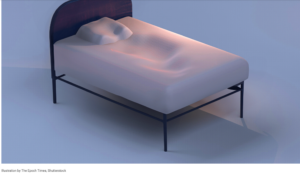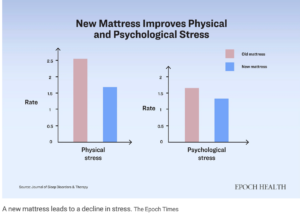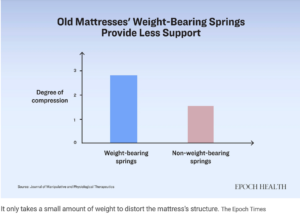
Could your mattress be the source of your pain? For some people, the answer is Yes! Flora Zhao, writing in The Epoch Times, tells us many people with unexplained symptoms simply need to replace their mattress.
“A lot of people wake up in the morning, and they will have a stiff back or a sore back. That may be a sign that the mattress is getting older,” Bert Jacobson, regents professor of applied health and educational psychology at Oklahoma State University, told The Epoch Times.
Over the past two decades, Jacobson has led and participated in a series of studies on mattresses. He has identified a common phenomenon: When people switch to a new mattress, the symptoms that once troubled them often disappear. In his research, many individuals reported no longer experiencing stiffness and pain upon waking, feeling more refreshed, and having less psychological stress. He noted that people may not realize that all these discomforts are related to what they’re sleeping on.
“The average age of a mattress is around 10 years old,” Jacobson said. In one of his earlier studies, 59 healthy participants who used the same mattresses for an average of 9.5 years reported mild sleep-related pain and compromised sleep quality. After switching to a new medium-firm mattress for four weeks, they experienced a 48 percent reduction in back pain, a 55 percent improvement in sleep quality, and an approximately 20 percent decrease in stress.
Another study involved participants whose mattresses had been in use for 11.3 years. They exhibited significant health improvements after switching to new mattresses. Their physical stress scores dropped from 2.57 to 1.73, their psychological stress decreased from 1.70 to 1.37, and they slept longer.

As an orthopedist, I have often recommended a new mattress for patients with low back pain. As a general rule, “Firmer is better.” Many people with low back pain will get better with a firmer mattress.
Recognizing that simply replacing a mattress can alleviate or eliminate pain and discomfort, Jacobson designed a study to examine the wear and tear of old mattresses, focusing on the most commonly used spring mattresses. He and his colleagues collected 32 old mattresses, the average age of which was nine years. By extracting and testing the weight-bearing springs from the center of the mattresses, as well as the non-weight-bearing springs from the head and foot, they found that although the mattresses appeared flat and the springs looked normal, the weight-bearing springs were weaker than the non-weight-bearing springs due to years of compression.
Specifically, when approximately 2.2 pounds of weight was applied to both types of springs, the weight-bearing springs were compressed by an average of 1.09 inches. In contrast, the non-weight-bearing springs were compressed by little more than half an inch, highlighting a significant difference.

Some people believe that their mattresses, despite years of use, are still in good condition, but this is just an illusion. Jacobson explained that non-weight-bearing areas of the mattress can appear visually flat, and since a bedspread always covers them, the mattress may even look relatively new. However, even a small amount of weight can cause significant deformation in the weight-bearing springs, potentially compromising their original structural support. This can result in poor sleep posture and a decline in sleep quality.
(Note: There are other threats within old mattresses besides pain. For more on these see Part II of this series.)

